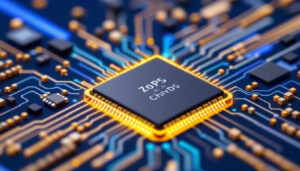Electronic waste has become a growing concern as technology accelerates. Traditional electronics manufacturing often relies on resource-heavy processes and hazardous components. This has led to increased pollution, resource depletion, and landfill waste that impacts both the planet and public health. “Top Eco Friendly Electronics for IT and Developers in 2025”
IT professionals, developers, and businesses now need to address these challenges by supporting sustainable solutions. Leading tech brands are responding with advances in materials, energy use, and eco-focused innovation. Understanding these shifts is essential for anyone shaping the future of electronics, as global regulations tighten and consumer expectations for responsibility rise.
New standards, such as those explored in the context of sustainability standards for electronics in 2025, signal a shift toward cleaner, more efficient practices. Businesses that prioritize eco-friendly electronics position themselves for long-term relevance and compliance in a changing market.
Eco-Friendly Design Principles Shaping the Electronics Industry
As stricter regulations and consumer demands guide the sector, electronics companies must adopt sustainable product design at every stage. The core principles now shaping the industry center on reducing energy use, prioritizing biodegradable and recycled materials, and creating products that last longer and are easier to repair or upgrade. These approaches support compliance with the 2025 electronics sustainability standards and align with concepts of circularity.
Energy Efficiency and Low-Impact Materials
 Photo by Tim Witzdam
Photo by Tim Witzdam
Using less energy and safer, recycled, or natural materials are now baseline requirements in electronic product design. Top electronics brands focus on not just reducing standby power, but also lowering operating consumption across all devices. Features like efficient power supplies, improved battery technology, and smart sensors minimize ongoing energy needs.
Material selection is equally strategic:
- Use of recycled plastics and metals significantly shrinks a product’s environmental footprint.
- Non-toxic components limit health hazards for users and manufacturing workers.
- Optimized product packaging cuts waste from shipment to end-user.
Industry leaders also look to certifications and independent testing standards as a guide. Firms actively seek ways to halve their greenhouse gas emissions through smarter design and supply chain choices. Additional insights on these principles are covered in how to design environmentally sustainable electronics.
Designing for Circularity: Modular and Upgradable Devices
The shift from linear to circular product lifecycles transforms how electronics are engineered. Instead of being discarded at the end of their lifecycle, devices designed for circularity can be easily repaired, upgraded, or repurposed, reducing electronic waste and resource extraction.
Key design approaches include:
- Modular components: Users can swap out or upgrade hardware (such as batteries or storage) without replacing the entire device.
- Standardized fasteners and layouts: Simplifies device disassembly and repair, supporting recyclability.
- Longer software support timelines: Devices remain secure and functional for years.
Brands leading in this area are releasing products that enable consumers or technicians to fix hardware quickly. This reduces costs over a device’s life and helps keep valuable resources in use. Such strategies not only improve environmental outcomes but also anticipate new requirements driven by 2025 electronics sustainability standards.
In-depth industry perspectives on these trends can be explored further in the context of how green technologies are shaping sustainable electronics. These principles hold strong potential for IT teams, developers, and businesses selecting hardware for longevity and compliance.
“Top Eco Friendly Electronics for IT and Developers in 2025”
Top Brands Leading the Green Electronics Movement
In today’s electronics industry, major brands are taking clear steps toward reducing their environmental footprint. Their efforts span climate goals, ethical sourcing, manufacturing efficiency, and better end-of-life solutions. The commitment and investment of these leaders set benchmarks for the rest of the industry and offer real-world models for sustainable progress.
Apple: Circular Supply Chains and Carbon Neutral Goals
Apple has set ambitious climate targets for its operations and supply chain. The company aims for all its products to be carbon neutral by 2030. Apple’s environmental efforts go beyond its direct footprint to include every phase of its devices’ lifecycle.
The company’s progress is grounded in a circular supply chain:
- 100% recycled aluminum is now standard in the frames of iPads, MacBooks, and other products.
- Recycled rare earth elements are incorporated in magnets for iPhones and other devices.
- Renewable energy initiatives power all Apple corporate facilities and much of its manufacturing.
Apple also advances device longevity with longer software updates and a robust trade-in and recycling program. Their closed-loop material recovery systems, such as the “Daisy” robot that disassembles iPhones for parts recovery, show how automation can extract high-quality materials from returned devices. Transparency is maintained through annual environmental progress reports, detailing emissions, material use, and supply chain practices.
Fairphone: Ethically Sourced and Repairable Devices
Fairphone has built its business model on ethical material sourcing and repair-friendly design. The company’s smartphones feature modular architecture, allowing users to swap or upgrade parts such as the battery and screen. This approach extends device lifespans and limits e-waste.
 Photo by Tima Miroshnichenko
Photo by Tima Miroshnichenko
Key highlights from Fairphone’s eco-initiatives include:
- Use of Fairtrade gold and responsibly sourced tin, tungsten, and tantalum.
- Supply chain audits to improve worker conditions and transparency.
- Easy-to-replace components included in product design manuals.
Fairphone’s leadership in right-to-repair advocacy has spurred change in how manufacturers approach product longevity. Detailed sustainability reporting and partnerships with environmental organizations help the company maintain ethical standards across its business.
Dell & HP: Sustainable Manufacturing and Recycled Materials Initiatives
Both Dell and HP have set clear sustainability targets that focus on greening their manufacturing and product lifecycle management. They are notable for integrating recycled materials and designing devices for easier disassembly at end-of-life.
Dell’s advances include:
- Use of ocean-bound plastics for packaging and some product casings.
- A closed-loop plastics supply chain that processes plastics from old electronics into new products.
- Sustainable operations programs that target energy and water reduction in factories.
HP has embraced:
- Recycled plastics from used cartridges and consumer electronics in their devices.
- A comprehensive hardware take-back program for responsible recycling.
- Product designs that use fewer unique fasteners, supporting repairs and recycling.
Both Dell and HP partner with industry groups to develop standards and certifications and provide detailed metrics on carbon, water, and material use in annual reports. These efforts reflect the direction described in Understanding Circuit Boards, where modern electronics increasingly depend on responsible supply chains and material choices.
Sony: Energy Reduction and Eco Packaging
Sony ties its consumer electronics sustainability to clear targets for both product design and business practices. The “Road to Zero” plan aligns with global climate targets, aiming to eliminate environmental impact across all operations by 2050.
Key elements of Sony’s contribution:
- Reduced standby and operational energy use in televisions, audio, and gaming products.
- Promotion of recyclable and less harmful materials in casings and components.
- Commitment to plastic-free packaging for select models, along with packaging that uses plant-based or recycled materials.
Sony’s reporting frameworks detail progress in energy efficiency, packaging redesign, and resource conservation. Their ongoing improvements in energy standards support buyers looking to upgrade electronics in 2025 while meeting upcoming environmental requirements.
The strategies employed by these top brands create reference points for IT and electronics decision-makers aiming for a less wasteful and more resource-efficient sector.
Innovative Sustainable Manufacturing: Technology and Materials
Advances in electronics manufacturing now center on environmental responsibility. Product development emphasizes smaller, more efficient components and smarter energy storage to reduce waste and raw material consumption. The impact is seen throughout manufacturing, from early design to the end of a device’s life. Continued progress in both technology and material science builds electronics that meet both productivity needs and planet health guidelines.
Miniaturization and Efficient Circuit Boards
 Photo by Mikhail Nilov
Photo by Mikhail Nilov
Product designers today address sustainability by making circuit boards smaller, lighter, and easier to recycle. Miniaturization decreases the amount of raw materials needed and reduces the energy consumed throughout assembly. These modern boards use less copper, smaller silicon chips, and multilayer designs that improve both space and performance.
Key developments in this area include:
- High-density interconnect (HDI) technology: Allows more connections on a smaller board, enabling compact device profiles.
- Lead-free solder: Reduces hazardous waste compared to traditional materials.
- Recyclable laminates: New substrate materials improve recyclability and lower product toxicity.
Thoughtful component layout also helps extend device lifetimes. Boards designed for serviceability allow easier repair, which supports circular economy goals and responds to repairability demands.
For a deeper technical overview, the article on Basics of circuit boards provides guidance on how efficient layouts and smart assembly practices advance both environmental and manufacturing goals. The shift to miniaturized and serviceable boards is further supported by industry best practices discussed in resources about sustainable electronic design.
Next-Gen Batteries and Reduced Environmental Impact
Batteries are central to the environmental profile of mobile and connected devices. New battery chemistry and improved manufacturing methods aim to reduce reliance on scarce minerals and ensure safer disposal at the end of product life.
Improvements in this area focus on:
- Solid-state batteries: Reduce flammable components and are easier to recycle.
- Cobalt-free cathodes: Address concerns around both resource scarcity and mining ethics.
- Enhanced recycling loops: Allow recovery of lithium, nickel, and other valuable materials from spent cells.
These developments support stricter global regulations and take a step toward closed material loops for electronics. Reduced battery weight and increased storage capacity also lower energy use for production, shipping, and product usage.
Manufacturers also invest in responsible sourcing practices and transparent reporting. Together, these steps move the sector closer to a future with lower waste and fewer environmental hazards.
For additional context on battery technology and its environmental trade-offs, see How lithium-ion batteries work. Broader strategies for implementing green practices across electronics manufacturing are outlined in Implementing Green Practices in Electronics Manufacturing. These advances, when paired with better materials, form the backbone of modern eco-friendly electronics.
Industry Standards, Compliance, and Future Trends
The path to eco-friendly electronics is shaped by both mandatory and voluntary standards. As demands for sustainable products increase, manufacturers are required to address compliance with global regulations. Voluntary frameworks and certifications also offer direction, helping brands lead by example. At the same time, wireless and smart technologies continue to affect the durability of electronics. Understanding these standards, certifications, and the evolving role of connectivity is essential for IT experts, developers, and businesses making informed decisions about the devices they purchase or design.
Key International and Regional Sustainability Standards
Regulatory requirements for electronics are becoming more demanding. Several international and regional standards now serve as benchmarks for sustainability and compliance:
- Restriction of Hazardous Substances (RoHS): Limits the use of specific hazardous materials in electrical and electronic products, which helps reduce environmental and health risks.
- Waste Electrical and Electronic Equipment Directive (WEEE): Sets requirements for end-of-life recycling and responsible disposal, especially in the European Union.
- Energy-Related Products Directive (ErP): Focuses on improving energy efficiency and reducing the carbon footprint of electronic products.
Beyond these, industry groups like the Global Electronics Council are updating frameworks to push the sector forward. The revised EPEAT® criteria, for instance, put new emphasis on climate action, circularity, and responsible supply chains. This is helping set higher standards globally, not only for manufacturers but also for procurement professionals looking to benchmark sustainability efforts. A recent overview of these updates can be found in the report on GEC’s raised sustainability standards for electronics.
In North America, voluntary programs such as Energy Star reward products that exceed basic regulatory requirements. Buyers can look for products that meet these standards to reduce energy costs and environmental impact over the device’s working life. For a deep dive into mandatory compared to voluntary requirements, see understanding environmental rules for electronics.
The Role of Wireless and Smart Technologies in Longevity
 Photo by wutthichai charoenburi
Photo by wutthichai charoenburi
Wireless and smart technologies are influencing how long electronics remain useful. New wireless standards support not only faster connectivity but also more energy-efficient devices. This directly impacts device longevity by reducing battery wear and improving system reliability.
Key factors that drive product lifespan include:
- Updates through the air: Devices can receive software fixes and security patches remotely, reducing the need for hardware replacements.
- Energy-efficient wireless chips: These extend battery life and reduce heat output, lowering the risk of early device failure.
- Interoperability standards: Products designed for compatibility with future wireless protocols avoid quick obsolescence.
The introduction of 6G and improvements in Wi-Fi protocols are expected to further enhance device performance. Such advances improve real-time updating and predictive maintenance capabilities. These features support long-term operation and compliance with upcoming regulations.
Readers interested in robust technical updates can look at emerging wireless standards 2025 to gain a clearer understanding of how connectivity standards will shape electronics lifecycles.
Certifications Driving Eco-Friendly Product Strategies
Certifications provide independent proof that electronics meet established environmental criteria. They help buyers and businesses select products that align with organizational sustainability goals.
Common certifications impacting eco-friendly product development include:
- EPEAT®: Assesses energy use, material content, recyclability, and corporate responsibility.
- Blue Angel (Germany): Recognizes devices with high energy efficiency and low emissions throughout the entire lifecycle.
- TCO Certified: Focuses on socially responsible manufacturing, environmental performance, and user safety.
- Energy Star: Signifies superior energy efficiency, especially for devices using less power during operation and in standby modes.
Brands use these certifications to differentiate products and meet procurement demands, especially in sectors where sustainability is a priority. IT buyers often require certifications as a baseline for purchase decisions. The ongoing development of certification criteria, such as EPEAT updates, plays a key role in encouraging more responsible product strategies across the sector.
Routine product audits and third-party verification provide transparency and ensure compliance remains current. Companies that maintain certification demonstrate not just regulatory compliance, but a proactive approach to reducing environmental risk and building trust with customers. Additional details on integrating these considerations into product choices can be found in sustainability standards for electronics in 2025.
“Top Eco Friendly Electronics for IT and Developers in 2025”
Conclusion
Eco-friendly electronics now represent a clear business and environmental advantage. Brands committed to sustainable sourcing, efficient energy use, and longer device lifespans drive greater cost savings and reduced risk for organizations. By adopting hardware and practices that promote easier repair, modularity, and responsible recycling, companies can support both compliance and long-term operational stability.
IT teams, developers, and business leaders who prioritize sustainable suppliers help lead the shift toward responsible technology. These choices support regulatory requirements and reinforce a reputation for forward-thinking stewardship.
For organizations interested in launching technology initiatives with sustainability in mind, Starting a Startup for IT and Electronics Professionals provides practical guidance.
The momentum toward greener electronics is accelerating. Thank you for reading—your commitment to responsible technology choices shapes a more sustainable future for all. Share your experiences or ideas to continue the conversation and drive meaningful impact.







